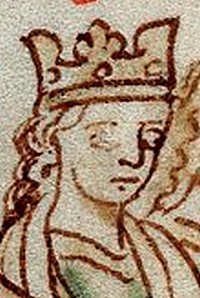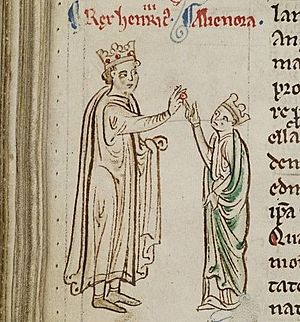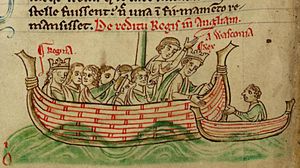Eleanor of Provence facts for kids
Quick facts for kids Eleanor of Provence |
|
|---|---|
 |
|
| Queen consort of England | |
| Tenure | 14 January 1236 – 16 November 1272 |
| Coronation | 20 January 1236 |
| Born | c. 1223 Aix-en-Provence, France |
| Died | 24/25 June 1291 Amesbury, Wiltshire, England |
| Burial | Amesbury Priory |
| Spouse | |
| Issue | Edward I, King of England Margaret, Queen of Scots Beatrice of England Edmund, Earl of Lancaster Katherine of England |
| House | Barcelona |
| Father | Ramon Berenguer IV, Count of Provence |
| Mother | Beatrice of Savoy |
| Religion | Roman Catholicism |
Eleanor of Provence (born around 1223 – died June 24 or 25, 1291) was a noblewoman from Provence, a region in southern France. She became the Queen of England when she married King Henry III. She was queen from 1236 until her husband's death in 1272.
Eleanor was very loyal to her husband. She strongly supported him against a rebel leader named Simon de Montfort. However, many people in London did not like her. This was because she brought many of her relatives from Provence to England. These relatives were called "the Savoyards." They were given important jobs in the government. Once, angry Londoners even threw things at Eleanor's boat.
Eleanor had five children, including Edward I, who would later become king. She was also known for being very smart. She was good at writing poetry and was a trendsetter in fashion.
Contents
Early Life in Provence
Eleanor was born in Aix-en-Provence, a city in southern France. She was the second daughter of Ramon Berenguer IV, Count of Provence and Beatrice of Savoy. Eleanor received a good education as a child. She loved to read, partly because of her teacher, Romée de Villeneuve.
Eleanor had three sisters, and all of them married kings. Her older sister, Margaret, married Louis IX of France. Eleanor's uncle, William of Savoy, then talked to Henry III of England. He convinced Henry to marry Eleanor. Henry wanted a large sum of money, called a dowry, for the marriage. But Eleanor's father was able to arrange it so that no dowry was needed right away. He promised to leave her money when he died.
Like her mother and grandmother, Eleanor was known for her beauty. She had dark hair and lovely eyes. One writer, Piers Langtoft, described her as "the fairest maiden alive." Eleanor became engaged to King Henry III on June 22, 1235. She was likely born in 1223. When she arrived in England for her wedding, she was about twelve years old.
Becoming Queen of England

Eleanor married King Henry III of England on January 14, 1236. She had never met him before the wedding. She also had never been to England. The wedding took place at Canterbury Cathedral. She wore a beautiful golden dress with long, fur-lined sleeves.
After the wedding, Eleanor rode to London. Many citizens greeted the royal couple. Eleanor was then crowned Queen of England at Westminster Abbey. A grand feast followed, with many important people attending. Eleanor's love for her husband grew stronger after their marriage.
Challenges as Queen
Eleanor was a loyal wife to Henry. However, she brought many uncles and cousins, known as "the Savoyards," with her to England. These relatives gained a lot of influence with the King. This made the English noblemen unhappy. For example, her uncle William of Savoy became a close advisor to the King. This upset many English barons.
Eleanor was very dedicated to her husband's cause. She strongly opposed Simon de Montfort, who led a rebellion. When Henry went to Gascony in 1253, Eleanor became the regent of England. This meant she ruled the country in his absence. She even raised troops in France to help Henry.
On July 13, 1263, Eleanor was sailing on the Thames River. Her boat was attacked by angry citizens of London. Eleanor disliked the Londoners, and they disliked her back. They threw stones, mud, pieces of pavement, rotten eggs, and vegetables at her boat. The Mayor of London, Thomas Fitzthomas, rescued her. She then found safety at the bishop of London's home.
Later Life and Death
In 1272, King Henry III died. Eleanor's son, Edward, who was 33 years old, became King Edward I. Eleanor remained in England as the queen dowager. This means she was the mother of the new king. She helped raise some of her grandchildren. These included Edward's son Henry and Beatrice's son John.
When her grandson Henry died in 1274, Eleanor was very sad. She ordered his heart to be buried at a priory she founded in his memory in Guildford. In 1275, her two remaining daughters, Margaret and Beatrice, also passed away.
In 1286, Eleanor retired to Amesbury Priory in Wiltshire. Her son, King Edward, visited her there. Two of her granddaughters were already nuns at the priory.
Eleanor died at the priory on June 24 or 25, 1291. She was buried there. However, the exact location of her grave is unknown. This makes her the only English queen without a marked grave. Her heart was taken to London and buried at a Franciscan priory called Greyfriars.
Eleanor's Legacy
Eleanor was known for being smart and educated. She was also skilled at writing poetry and was considered a very beautiful woman. She was a leader in fashion, often bringing new clothes from France. She liked red silk and often wore colorful tunics. She also wore gold or silver belts with a dagger tucked into them. To cover her dark hair, she wore stylish small hats. Eleanor also brought a new style of head covering, called a wimple, to England.
As a child, she loved the songs of the troubadours, who were poets and musicians. She continued this interest as an adult. She bought many romantic and historical books. These books included stories from ancient times and new romances written in her own time.
Eleanor is a main character in several historical novels. These include The Queen From Provence by Jean Plaidy and Four Sisters, All Queens by Sherry Jones. She is also featured in the song "Eleonore De Provence" by the band Leave's Eyes.
Her Children
Eleanor and Henry had five children together. Eleanor was especially close to her oldest son, Edward. When he was very sick in 1246, she stayed with him for three weeks. She also personally oversaw his upbringing and education. Because of her influence, King Henry gave the region of Gascony to Edward in 1249.
Her youngest child, Katherine, seemed to have a health problem that made her deaf. When Katherine died at the age of three, both Eleanor and Henry were heartbroken. It is possible Eleanor had four other sons who died as babies, but there are no clear records of them.
- Edward I (1239–1307): He married Eleanor of Castile and later Margaret of France. He had children, including his heir, Edward II.
- Margaret (1240–1275): She married King Alexander III of Scotland and had children.
- Beatrice (1242–1275): She married John II, Duke of Brittany and had children.
- Edmund Crouchback, 1st Earl of Lancaster (1245–1296): He married Aveline de Forz and later Blanche of Artois. He had children with Blanche.
- Katherine (November 25, 1253 – May 3, 1257)
See also
In Spanish: Leonor de Provenza para niños


